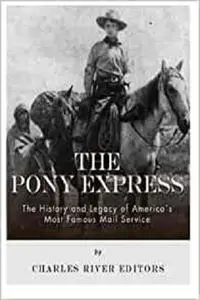The Pony Express: The History and Legacy of America's Most Famous Mail Service by Charles River Editors
English | November 13, 2013 | ISBN: 149375050X | 50 pages | EPUB | 1.26 Mb
English | November 13, 2013 | ISBN: 149375050X | 50 pages | EPUB | 1.26 Mb
*Includes pictures of important people, places, and events.
*Explains the route of the Pony Express and accounts from Pony Express riders.
*Includes footnotes and a bibliography for further reading.
"I, [name], do hereby swear, before the Great and Living God, that during my engagement, and while I am an employee of Russell, Majors, and Waddell, I will, under no circumstances, use profane language, that I will drink no intoxicating liquors, that I will not quarrel or fight with any other employee of the firm, and that in every respect I will conduct myself honestly, be faithful to my duties, and so direct all my acts as to win the confidence of my employers, so help me God." – The oath taken by Pony Express riders
Although it was only in operation for about 18 months, the Pony Express remains the most famous and romanticized mailing system in American history, and it still instantly brings to mind all of the old themes of the untamed frontier and the Wild West. Starting shortly before the Civil War erupted across the United States, the Pony Express connected the east and west by having riders deliver mail from St. Joseph, Missouri to Sacramento, California, a route setup by previous explorations and a system of relay stations and waypoints. When working in perfect unison, the Pony Express dramatically cut down the time it took to travel to California, with the mail traveling nearly 1,900 miles to California just 10 days after the beginning of the journey in Missouri. Naturally, the Pony Express also ran from west to east as well.
Of course, part of the allure of the Pony Express is in the way it challenged riders and horses, which ties it to Americans’ fond visions of the frontier as an untamed landscape that only the most pioneering and rugged individuals could survive. At the same time, the Pony Express needed small riders to reduce the weight being carried by the horses; Mark Twain described the Pony Express riders he saw as "usually a little bit of a man." To get from St. Joseph to Sacramento, riders would generally switch horses every 10 miles at a new stop, and riders traveled at all hours of the day, sometimes riding 20 straight hours to reach the destination on time. Riders typically traveled over 70 miles a day, working in tough conditions and not necessarily safe ones, given the fact that the routes forced them to contend with bandits and potentially hostile Native Americans nearby. The most notable disruption came during the Paiute War, when members of the Paiute tribe attacked Pony Express outposts, but it would ultimately be technological advances that made the Pony Express obsolete. The advent of telegraph lines in the early 1860s eventually made communication between east and west much faster, easier, and safe.
The Pony Express: The History and Legacy of America’s Most Famous Mail Service comprehensively examines the history of the Pony Express from beginning to end, explaining how it operated and who worked for it. Along with pictures of important people, places, and events, you will learn about the Pony Express like never before, in no time at all.
Feel Free to contact me for book requests, informations or feedbacks.
Without You And Your Support We Can’t Continue
Thanks For Buying Premium From My Links For Support
Without You And Your Support We Can’t Continue
Thanks For Buying Premium From My Links For Support



